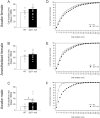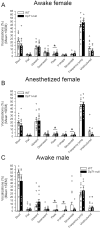Social and emotional alterations in mice lacking the short dystrophin-gene product, Dp71
- PMID: 39182120
- PMCID: PMC11344925
- DOI: 10.1186/s12993-024-00246-x
Social and emotional alterations in mice lacking the short dystrophin-gene product, Dp71
Abstract
Background: The Duchenne and Becker muscular dystrophies (DMD, BMD) are neuromuscular disorders commonly associated with diverse cognitive and behavioral comorbidities. Genotype-phenotype studies suggest that severity and risk of central defects in DMD patients increase with cumulative loss of different dystrophins produced in CNS from independent promoters of the DMD gene. Mutations affecting all dystrophins are nevertheless rare and therefore the clinical evidence on the contribution of the shortest Dp71 isoform to cognitive and behavioral dysfunctions is limited. In this study, we evaluated social, emotional and locomotor functions, and fear-related learning in the Dp71-null mouse model specifically lacking this short dystrophin.
Results: We demonstrate the presence of abnormal social behavior and ultrasonic vocalization in Dp71-null mice, accompanied by slight changes in exploratory activity and anxiety-related behaviors, in the absence of myopathy and alterations of learning and memory of aversive cue-outcome associations.
Conclusions: These results support the hypothesis that distal DMD gene mutations affecting Dp71 may contribute to the emergence of social and emotional problems that may relate to the autistic traits and executive dysfunctions reported in DMD. The present alterations in Dp71-null mice may possibly add to the subtle social behavior problems previously associated with the loss of the Dp427 dystrophin, in line with the current hypothesis that risk and severity of behavioral problems in patients increase with cumulative loss of several brain dystrophin isoforms.
Keywords: Anxiety; Dp71; Dystrophin; Dystrophinopathies; Fear memory; Social behavior; Ultrasonic vocalizations.
© 2024. The Author(s).
Conflict of interest statement
The authors declare no competing interests.
Figures








References
-
- American Psychiatric Association. Diagnostic and statistical manual of mental disorders. 5th ed. Arlington (VA): American Psychiatric Publishing; 2013.
-
- Balemans MC, Huibers MM, Eikelenboom NW, Kuipers AJ, van Summeren RC, Pijpers MM, Tachibana M, Shinkai Y, van Bokhoven H, Van der Zee CE. Reduced exploration, increased anxiety, and altered social behavior: autistic-like features of euchromatin histone methyltransferase 1 heterozygous knockout mice. Behav Brain Res. 2010;208:47–55. 10.1016/j.bbr.2009.11.008 - DOI - PubMed
MeSH terms
Substances
Grants and funding
LinkOut - more resources
Full Text Sources

